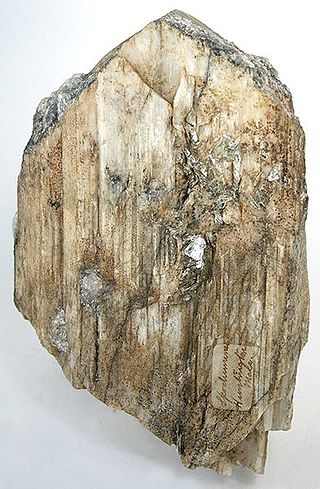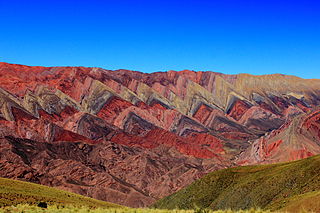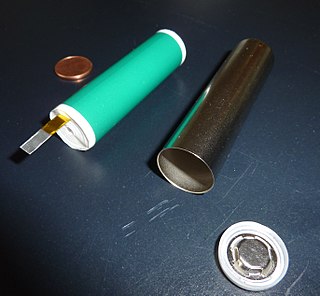
Lithium is a chemical element; it has symbol Li and atomic number 3. It is a soft, silvery-white alkali metal. Under standard conditions, it is the least dense metal and the least dense solid element. Like all alkali metals, lithium is highly reactive and flammable, and must be stored in vacuum, inert atmosphere, or inert liquid such as purified kerosene or mineral oil. It exhibits a metallic luster. It corrodes quickly in air to a dull silvery gray, then black tarnish. It does not occur freely in nature, but occurs mainly as pegmatitic minerals, which were once the main source of lithium. Due to its solubility as an ion, it is present in ocean water and is commonly obtained from brines. Lithium metal is isolated electrolytically from a mixture of lithium chloride and potassium chloride.

Lithium carbonate is an inorganic compound, the lithium salt of carbonic acid with the formula Li
2CO
3. This white salt is widely used in processing metal oxides. It is on the World Health Organization's List of Essential Medicines for its efficacy in the treatment of mood disorders such as bipolar disorder.

Spodumene is a pyroxene mineral consisting of lithium aluminium inosilicate, LiAl(SiO3)2, and is a commercially important source of lithium. It occurs as colorless to yellowish, purplish, or lilac kunzite (see below), yellowish-green or emerald-green hiddenite, prismatic crystals, often of great size. Single crystals of 14.3 m (47 ft) in size are reported from the Black Hills of South Dakota, United States.

Jujuy is a province of Argentina, located in the extreme northwest of the country, at the borders with Chile and Bolivia. The only neighboring Argentine province is Salta to the east and south.

Lithium hydroxide is an inorganic compound with the formula LiOH. It can exist as anhydrous or hydrated, and both forms are white hygroscopic solids. They are soluble in water and slightly soluble in ethanol. Both are available commercially. While classified as a strong base, lithium hydroxide is the weakest known alkali metal hydroxide.

Searles Lake is an endorheic dry lake in the Searles Valley of the Mojave Desert, in northwestern San Bernardino County, California. The lake in the past was also called Slate Range Lake and Borax Lake.

Sociedad Química y Minera de Chile (SQM) is a Chilean chemical company and a supplier of plant nutrients, iodine, lithium and industrial chemicals. It is the world's biggest lithium producer.
Lithium Corporation of America was a mining company which mined lithium-bearing spodumene and pegmatite ores near Bessemer City, Gaston County, North Carolina, United States and in the Black Hills of South Dakota.
The Kings Mountain Mine is a large open-pit mine on the south side of the eponymous town of Kings Mountain and north of Interstate 85 in Cleveland County, North Carolina. Its open-pit has been excavated in one of the largest bedrock lithium deposits in the United States. In 2013, it was reported that the Kings Mountain mine had reserves amounting to 45.6 million tonnes of lithium ore grading 0.7% lithium thus resulting 0.32 million tonnes of lithium. In 2017 it was reported that the Kings Mountain pegmatite district had 5.9 million metric tons of lithium.

Greenbushes mine is an open-pit lithium mining operation located south of the town of Greenbushes, Western Australia. It is the world's largest hard-rock lithium mine, producing approximately 1.95 million tonnes of lithium spodumene annually. The mine is 250 kilometres south of Perth and 90 kilometres southeast of the port of Bunbury.
The Mt Cattlin mine is a spodumene-tantalite mine 2.2 kilometres (1.4 mi) north of Ravensthorpe, Western Australia. In 2019 Mt Cattlin had a reserve of 8.2 million tonnes of ore grading 1.29% Li
2O and 155 ppm Ta
2O
5.

The Salar de Olaroz mine is one of the largest lithium mines in Argentina. The mine is located in northern Argentina in Jujuy Province. The Salar de Olaroz mine has reserves amounting to 619 million tonnes of lithium ore grading 0.2% lithium thus resulting 1.21 million tonnes of lithium.
Galaxy Resources Limited was an Australian public mining company. It was listed on the Australian Securities Exchange until it merged with fellow lithium producer Orocobre in August 2021 to form Allkem.

Brine mining is the extraction of useful materials which are naturally dissolved in brine. The brine may be seawater, other surface water, groundwater, or hyper-saline solutions from several industries. It differs from solution mining or in-situ leaching in that those methods inject water or chemicals to dissolve materials which are in a solid state; in brine mining, the materials are already dissolved.
Pilbara Minerals is a Perth-based ASX listed company, owning 100% of the world’s largest, independent hard rock lithium operation. Located in Western Australia’s Pilbara region, Pilbara Minerals’ Pilgangoora Operation produces spodumene and tantalite concentrates.

Australia has one of the biggest lithium reserves and is the biggest producer of lithium by weight, with most of its production coming from mines in Western Australia. Most Australian lithium is produced from hard-rock spodumene, in contrast to other major producers like Argentina, Chile and China, which produce it mainly from salt lakes.

Salar del Hombre Muerto is a salt pan in Argentina, in the Antofagasta de la Sierra Department on the border between the Salta and Catamarca Provinces. It covers an area of 600 square kilometres (230 sq mi) and is in part covered by debris. During the Pleistocene it was sometimes a lake, but today only parts of the salt pan are covered by perennial water bodies; its major tributary is the Río de los Patos.

Lithium batteries are batteries that use lithium as an anode. This type of battery is also referred to as a lithium-ion battery and is most commonly used for electric vehicles and electronics. The first type of lithium battery was created by the British chemist M. Stanley Whittingham in the early 1970s and used titanium and lithium as the electrodes. Applications for this battery were limited by the high prices of titanium and the unpleasant scent that the reaction produced. Today's lithium-ion battery, modeled after the Whittingham attempt by Akira Yoshino, was first developed in 1985.
The Finnis Lithium mine is a lithium mine situated near Darwin in the Northern Territory, Australia. It is being developed by Core Lithium.

Arcadium Lithium plc is a specialty chemicals manufacturing company focused on lithium production. It was formed in January 2024 from the merger of Livent, an American special chemicals company, and Allkem, an Australian lithium mining company. The new company, Arcadium Lithium, became the world's third-largest lithium producer. It is cross-listed in both the New York Stock Exchange and the Australian Securities Exchange.












